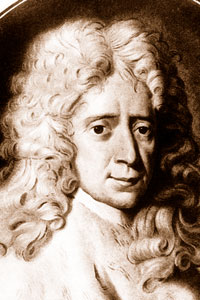 Jennet Stearne’s father hangs witches for a living in Restoration England. But when she witnesses the unjust and horrifying execution of her beloved Aunt Isobel, the precocious child decides to make it her life’s mission to bring down the Parliamentary Witchcraft Act of 1604.
Jennet Stearne’s father hangs witches for a living in Restoration England. But when she witnesses the unjust and horrifying execution of her beloved Aunt Isobel, the precocious child decides to make it her life’s mission to bring down the Parliamentary Witchcraft Act of 1604.
Armed with little save the power of reason, and determined to see justice prevail, Jennet hurls herself into a series of picaresque adventures—traveling from King William’s Britain to the fledgling American Colonies to an uncharted island in the Caribbean, braving West Indies pirates, Algonquin Indian captors, the machinations of the Salem Witch Court, and the ardent admiration of a young Ben Franklin. For Jennet cannot and must not rest until she has put the last witchfinder out of business.
Buy the Tree-Book or E-Book at Amazon
Buy the Tree-Book or E-Book at Barnes & Noble
Buy it at IndieBound
* * *
WHAT THE CRITICS SAID
“[A] picaresque tale steeped in philosophical debate … Here are storytelling, showmanship and provocative book-club bait (try finding another recent novel that rivals this one for erudite talking points), all rolled into one inventive feat.”
New York Times
“[Morrow] pulls off so many dazzling feats of literary magic that in a different century he’d have been burned at the stake. Forget The Crucible, Arthur Miller’s dreary classic. Forget the repugnant kitsch of modern-day Salem. The Last Witchfinder flies us back to that thrilling period when scientific rationalism was dropped into the great cauldron of intellectual history, boiling with prejudice, tradition, piety, and fear. The result is a fantastical story mixed so cunningly with real-life details that your vision of America’s past may never awaken from Morrow’s spell.”
Washington Post Book World
“Morrow’s prise, lucid as amber, is itself an argument against unnecessary embellishments … Grim and gorgeous, earthy and erudite as well, Morrow’s Witchfinder woos readers with a secularist vision of reason triumphant, rewarding its followers richly, giving them all the world and ample time in which to enjoy it.”
“[An] historical fiction tour de force … The elaborate text is studded with facts and redolent with the era’s lush language … [A] book to delight fans of writers such as John Barth and T. C. Boyle. Or even Jonathan Swift.”
“Morrow’s panoramic vision of the Enlightenment encompasses the ideology of that turbulent, transformative era, and his wry commentary—related in the sprightly voice of Newton’s Principia Mathematica, speaking for itself—lightens the novel’s tone without softening its message. This impeccably researched, highly ambitious novel—nine years in the writing—is a triumph of historical fiction.”
“James Morrow brings to life the clash between science and superstition through his heroine, Jennet Stearne, a vivacious Colonial feminist before her time … [The Last Witchfinder] is intelligent, funny, lively—not to mention strange as a witch’s brew … Morrow concocts a thrilling ending, with his heroine willing to sacrifice everything for the love of science.”
“Morrow focuses on an historical moment that gives his philosophical inclinations full play: that divide, which opened up in the late seventeenth century, between ‘traditional’ society and the Enlightenment … [The] incidents and characters have a bawdy, eighteenth-century liveliness that forms a pleasingly surprising fit with our modern sensibilities.”
“[An] historical fantasy as full of escapes and voyages and kidnappings as any eighteenth-century picaresque novel … Morrow is a likable and highly learned writer. With appealing ease, he draws on everything from demonology to Algonquin linguistics. And, no mean feat, he keeps it lively.”
“Morrow’s richly detailed, cerebral tale of rationality versus superstitious bigotry is set in late-17th-century London and colonial New England, a time when everyday actions were judged according to the rigid Parliamentary Witchcraft Act and suspect women were persecuted for alleged acts of sorcery … For a metafictional touch to this intrepid, impeccably researched epic, Newton’s Principia Mathematica speaks intermittently, its jaunty historical and critical commentary knitted cleverly into the narrative. This tour-de-force of early America bears a buoyant humor to lighten its macabre load.”
“The protagonist of Morrow’s latest novel is a self-confident young woman named Jennet Stearne, whose father is a witchfinder in late 17th-century England; upon his death, her brother picks up their father’s mantle to scourge Satan in Salem, MA … Picaresque heroes typically rattle through history, reacting to rather than shaping the near-fantastic mishaps that befall them, but not Jennet! Jennet is a magnet for continual controversy but is determined to win through and does. She is an attractive heroine in an exceptionally engaging and piquantly thoughtful novel. Though similar to John Barth’s The Sot-Weed Factor in many respects, Witchfinder is warmer and more human. Strongly recommended.”
* * *
THE STORY IN BRIEF
The Last Witchfinder tells of Jennet Stearne, who makes it her life’s mission to bring down the 1604 Parlimentary Witchcraft Act. She is aided in this endeavor by some luminaries of her day: |
|||||
|
Benjamin Franklin
|
Sir Isaac Newton
|
Baron de Montesquieu
|
|||
| We first meet Jennet as a precocious child studying natural philosophy with her Aunt Isobel, a landed Ipswich widow. Even as Isobel, Jennet, and a second pupil, Elinor Mapes, perform their experiments, Jennet’s father — Walter Stearne, the Witchfinder-General — tours the countryside with his son Dunstan, submitting suspected Satanists to his tests of demonic compact. |  |
||||
 |
Elinor’s father, Reverend Mapes, worries that Isobel’s experiments partake of blasphemy. Walter applies the witch tests, soon determining that his sister-in-law is indeed a Satanist. Isobel is tried, convicted, and condemned to death. Before the sentence is carried out, Isobel makes Jennet promise that she will devote her life to destroying the Witchcraft Act. | ||||
| Furious at Walter for executing a landholder, King William banishes him to Massachusetts. Jennet is dismayed: how can she pursue her mission in a backwater province? Arriving in Haverhill, Walter finds employment advising the Salem Witch Court on whether the suspects’ blemishes are indeed the notorious marks with which Satan brands his disciples. | 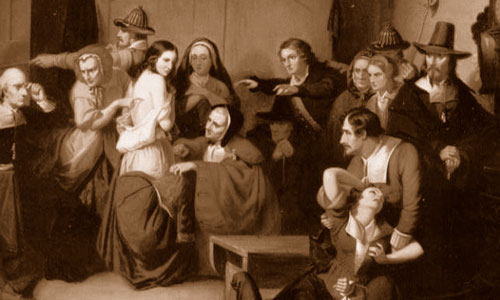 |
||||
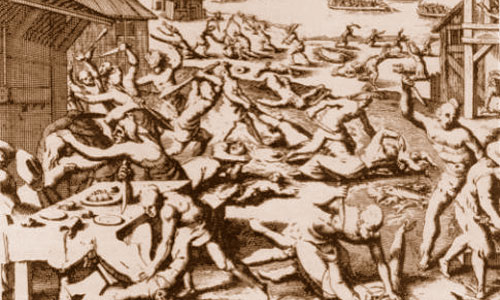 |
Jennet’s family returns to Haverhill, from which Walter and Dunstan launch additional witch hunts. Their enterprise comes to an abrupt halt when Algonquin Nimacooks burn the town and abduct Jennet. A new life lies before our heroine, different from anything she has experienced before. | ||||
| Several years into her Nimacook captivity, Jennet visits the Bedford Trading Post, where some demonologists are “swimming a witch.” If the suspect floats, she has clearly compacted with Satan, for running water cannot abide a heretic. Jennet realizes that she must resume her campaign against the Witchcraft Act. |  |
||||
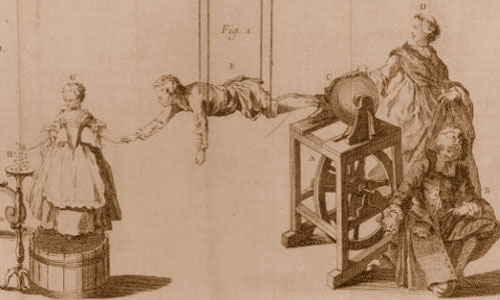 |
After her escape from the Nimacooks, a marriage of convenience to a Colonial postmaster enables Jennet to write her treatise. Complications ensue, designs go awry, and Jennet is once again on her own until she meets the young Benjamin Franklin, whose electricity experiments generate romantic sparks. | ||||
| Plagued with doubts about her treatise, Jennet accompanies Ben to England, hoping a change of venue will prove inspirational. In London she encounters an old friend, a long-lost child, and the illustrious Isaac Newton. An epiphany at the King’s Theater makes Jennet more determined than ever to fulfill her quest. | 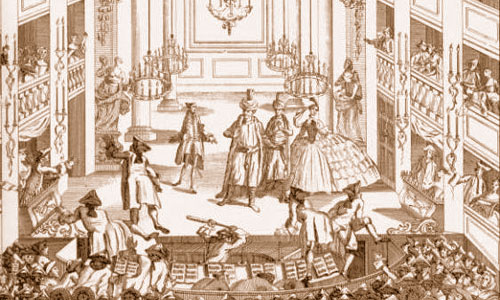 |
||||
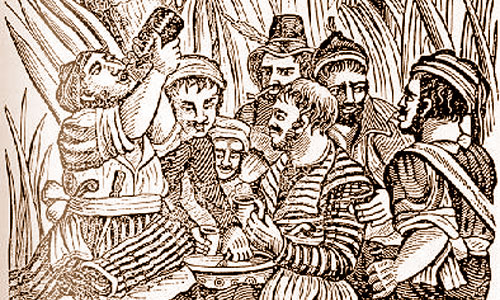 |
During their return voyage Jennet and Ben are shipwrecked on a Caribbean island, where our heroine at last devises a satisfactory demon disproof. But how will she bring her insights back to civilization? When a band of gold-hungry pirates appears, the stranded philosophers enact a bold plan for their deliverance. | ||||
| Back in Philadelphia, Jennet puts herself on trial for witchcraft, thus acquiring a public forum for presenting her demon disproof. Perhaps she will be acquitted, since her lawyer is the brilliant Baron de Montesquieu. But the judge is John Hathorne, who once sent eighteen Salem defendants to the gallows. |  |
||||
Q: Book reviewers have categorized your previous novels as wild Vonnegutian satires full of fantastical and even surrealistic events. Why this sudden leap into straight historical fiction?
A: The leap was a long time coming. About twenty years ago I had a mind-boggling encounter with a single sentence in Masks of the Universe, a history of science by the physicist-astronomer Edward Harrison. At one point Harrison asserts that the “witch universe,” the zeitgeist of the late Renaissance, would have “destroyed European society but for the intervention of science.” And I said to myself, “What a great subject for a novel!” Even if Harrison was overstating the case, I simply had to explore that astonishing idea, the near destruction of a civilization by its own theology.
Q: So you spent twenty years researching and writing The Last Witchfinder? You have a long attention span.
A: Not the past twenty years, no. I kept deferring the project, daunted by its scope, and composed other sorts of fiction instead. But I never stopped thinking about Harrison’s riveting sentence, and then about eight years ago I took the plunge and committed myself to writing a magnum opus about the shift from the “witch universe” to our modern, scientific world-picture. Before long I realized that a woman born around 1678 — don’t ask me why, but I knew the main character had to be a woman — would have lived through the great transition, and so The Last Witchfinder became the story of Jennet Stearne, who makes it her life’s mission to bring down the Parliamentary Witchcraft Act of 1604.
Q: Why did the main character have to be a woman?
A: I’ve always enjoyed creating strong female protagonists. My fourth novel, Only Begotten Daughter, recounts the adventures of Jesus Christ’s divine half-sister in contemporary Atlantic City. By placing a woman at the center of The Last Witchfinder, I believe I made the Renaissance-to-Reason rotation more engaging than if I’d used a male protagonist. Obviously a woman would face an uphill battle convincing the world that she has discovered a scientific refutation of the “demon hypothesis.” And I thought there would be a certain poetic justice in having a heroine, as opposed to a hero, put the witchfinders out of business, since women endured a disproportionate amount of persecution during “the burning times.” Indeed, the main reason Jennet goes on her quest is that, early in the novel, her beloved Aunt Isobel is publicly executed as a Satanist.
Q: Jennet Stearne is a formidable heroine: brilliant, sharp-tongued, courageous. But why would even the cleverest 17th-century woman imagine she had the intellectual and political resources to destroy the “witch universe”?
A: Throughout her quest, Jennet takes heart in a kind of talisman bestowed on her by Aunt Isobel: a letter from Isaac Newton in which he implies that a “demon disproof” lies hidden between the lines of his scientific masterwork, the Principia Mathematica. Jennet comes to believe that, by studying the Principia, she’ll uncover an argument that will persuade the English legislature to overturn the Witchcraft Statute. After several false starts, she manages to write a persuasive treatise, but then she faces an even bigger problem: convincing Parliament to read it. And so, in a daring move, Jennet puts herself on trial for witchcraft in Colonial Philadelphia, using the attendant “media circus” to publicize her argument.
Q: Is Jennet based on a real person?
A: No, though many women of this era, through their salons and soirées, were passionately involved with the new mechanical science — or, as it was called then, “natural philosophy” — of Descartes and Newton. The recent epochal exhibit at the New York Public Library called The Newtonian Moment featured a gallery of “Newtonian Women,” among them Laura Bassi, Diamante Medaglia Faini, Maria Gaetana Agnesi, and Voltaire’s celebrated collaborator, Madame du Châtelet. In the 1750’s Oliver Goldsmith, noting the phenomenon of women wedding themselves to natural philosophy, remarked that a man “who would court a lady must be capable of discussing Newton and Locke.”
Q: So Jennet is your own creation, but many actual historical figures parade through the novel: Benjamin Franklin, Isaac Newton, Robert Hooke, Cotton Mather, the Baron de Montesquieu.
A: The real catalyst for The Last Witchfinder — the event that got me moving beyond Edward Harrison’s inspiring sentence — was my discovery of an obscure historical fact: in 1725 the young Benjamin Franklin, age eighteen, traveled to London on a mission for the Pennsylvania Royal Governor, and eventually penetrated Newton’s inner circle, hoping to meet the genius behind the theory of universal gravitation. But Newton saw no reason to waste an afternoon talking to some cheeky kid from Philadelphia .
Q: But in The Last Witchfinder Newton and Franklin really do meet.
A: I realized that I could use these fascinating characters as symbols of the two universes: Newton the avatar of the Renaissance, as pious a man who ever lived, versus Franklin the quintessential Enlightenment skeptic, eternally playful and irreverent. When they finally cross paths in my novel, they have nothing to say to each other. Newton wants to talk about the great preoccupation of his dotage, biblical prophecy, and Franklin wants to talk about electricity. The problem isn’t just that they’re from two different continents and two different generations. They’re also from two different universes.
Q: Extreme cases to be sure. But wouldn’t it be fair to say that most people during this period lived in both universes at the same time?
A: Indeed. That’s what makes the worldview of early modern Europe — and its counterpart in Colonial America — so compelling. For Jennet’s generation, demonology and the new mechanical philosophy were not ipso facto incompatible. We tend to think of witchcraft as a mere superstition, belonging largely to the Middle Ages or even the Dark Ages, but the theology of Satanism was actually quite sophisticated, flowering fully only during the Renaissance. For nearly a century, the Age of Demons and the Age of Demonstrations overlapped. Many members of the Royal Society, most famously Robert Boyle, believed that evil spirits were a fact. And, of course, the various “proofs” of Satanic compact were ostensibly “scientific.” It stood to reason, for example, that the Devil endowed his disciples with special teats for suckling their animal familiars, and so the witchfinder would search the suspect’s skin until he found an unusual excrescence, then prick it with a needle: if the “nipple” failed to bleed, this confirmed its demonic nature. It was equally plausible to assert that pure water, the medium of baptism, would reject a disciple of Lucifer: hence the practice of “swimming the witch” — tossing her into a river and then, if she floated, declaring her a Satanist.
Q: This large theme of yours, the clash between Renaissance theology and Enlightenment science — for some prospective readers, it may sound a trifle dry.
A: Or even dull?
Q: Or even dull. And yet The Last Witchfinder is a rollicking, satiric, picaresque, and sometimes bawdy adventure. As the plot progresses, Jennet runs afoul of Indians, pirates, whores, scoundrels, charlatans, hurricanes, and a smallpox epidemic.
A: My models included those juicy, spirited, comic novels of the 17th and 18th centuries — Laurence Sterne’s Tristram Shandy, Henry Fielding’s Joseph Andrews, and, of course, Voltaire’s Candide — that people still read today with pleasure. I especially enjoyed juxtaposing the scientific and the erotic, as when Jennet and Ben Franklin seduce each other while performing an experiment with a rotating sulphur ball. They’re diligently determining the degree to which a human body can conduct static electricity, and soon they’re sparkling and crackling with mutual desire, and before long they’re swiving on the mattress in Ben’s garret.
Q: Swiving?
A: It rhymes with driving.
Q: You mentioned that the encounter between Newton and Franklin never really happened — but many of the events in the novel are historically accurate, yes?
A: I was continually delighted by now much real history I could incorporate into The Last Witchfinder. It seemed as if these glittering shards of the past were lying around in a field, and all I had to do was glue them together into an urn of my own design.
Q: Almost as if the book was asking to be written?
A: Exactly. At one point the storyline required Jennet to be abducted by Algonquin Indians from her home in Haverhill, Massachusett s. Well, it turned out that the Abenaki tribe really did attack Colonial Haverhill in 1696. When Jennet puts herself on trial for witchcraft, I thought it would be interesting if the Baron de Montesquieu — another personification of the Enlightenment — came forward to defend her. So naturally I was pleased to discover that, not only had Montesquieu denounced the conjuring statutes, he was a world traveler and could easily have landed in Colonial Philadelphia at this time. Even the climactic courtroom battle has a rough historical counterpart. In a 1730 issue of The Pennsylvania Gazette, Franklin reported on a witch trial that had supposedly occurred across the Delaware River — in Mount Holly, New Jersey. The article is clearly a hoax, but I decided to take Ben at his word.
Q: Evidently you did a lot of research.
A: More that I care to think about. I began with weighty tomes like Stuart Clark’s Thinking with Demons and Bernard Cohen’s Franklin and Newton. At one point I even waded into Andrew Motte’s famous English translation of the Principia Mathematica. Thanks to a rigorous high school calculus class, I more-or-less understood what was going on. The real fun was the legwork I did on both sides of the Atlantic. Eventually I spent a week in England, following in Jennet’s footsteps as she encounters Robert Hooke at Cambridge University, witnesses Aunt Isobel’s execution behind Colchester Castle, and tracks down Newton in London.
Q: We began by talking about The Last Witchfinder as your foray into straight historical fiction. But the novel has one frankly fantastical dimension. The narrator technically is not James Morrow but rather Newton’s Principia Mathematica. From the first sentence onward, you give us a world in which books have minds, souls, and a passion to write other books.
A: I’d always envisioned The Last Witchfinder as a qualified defense of the 18th-century Enlightenment. And yet these days, I’ve noticed, the Age of Reason has few friends. The religious right detests the Enlightenment because it leads to secularism; postmodern academics reject the Enlightenment as the presumed progenitor of an oppressive scientism; and the New Age fringe invites us to regard Reason as Spirituality’s feeble and overrated shadow. So from the instant I started composing chapter one, I wanted to incorporate a contemporary perspective — not only to give the anti-Enlightenment argument its due, but as a way to avoid the bane of historical fiction: characters who are implausibly aware of what their lives will mean to their descendants. At first I tried to achieve this distance by having Aunt Isobel compose a long, prophetic poem in which she foresees the French Revolution and other disasters accruing to the apotheosis of Reason. But it didn’t ring true, and so I tried an even stranger ploy: turning the narration over to Newton’s Principia, a sentient book living outside the bounds of time and space.
Q: Your Principia narrator invites us to regard the witch-persecution era as a mirror of our present age. Do you see The Last Witchfinder as an allegory on the contemporary problem of faith versus rationality?
A: If satire is what closes on Saturday night, allegory doesn’t even get into the theater — nor should it. The last thing I had in mind was inflicting an uplifting lesson on the reader. That said, we’re obviously living in an age when theology is again leading people down some very dark paths indeed. Whether we’re talking about the rise of jihadism or recent attempts to cast “intelligent design” as commensurate with Darwin’s theory of natural selection, the shadow side of religious faith is haunting the West. So if I had to tease a message out of The Last Witchfinder, I would paraphrase Churchill and hold forth as follows: Reason is the worst possible mode in which to negotiate the world — except for all the others.




